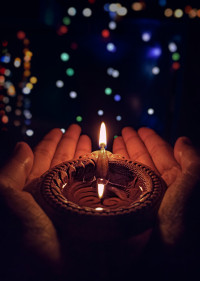As it is
A thing or two about art
The critique of art may be harsh, but paint itself retains the quality of healing. It covers any deficiencies without contest or contempt..jpg&w=900&height=601)
Asmita Manandhar
My strokes were clumsy to say the least. The colours were a ragged mess while I was trying hard to control the movements of my wrist and fingers. But it wasn’t working. I could feel the scorn of my paint, brushes and canvas, punishing me for stuffing them into a corner drawer for a year, and not looking back once.
When I transitioned from my sketchbooks to large canvases, it opened up a new dimension for me. I was like a child, discovering a bigger playground in the same neighbourhood. But one thing bothered me—canvases aren’t as quiet as sketchbooks, and they demand an audience, ready or not. Especially when your mother insists that they be hung around the walls of her home.
Having no formal education in fine arts, I was afraid to share my work. I felt like I was stepping into an uninvited space, or rather intruding into an emotionally and intellectually taxing world of art. I was scared that my knowledge of colours, form and technique, or lack thereof, trivialised the art form.
The exercise was even more dreadful when the art was a representation of a small fragment of my personal experience or interpretation. I had read about how art students from the best universities around the world often burst into tears during “group crit”, short for critique. One student even compared these peer reviews or classroom critique sessions to standing nude in front of a group of people, and that too, beside a scale.
In my case, however, it was my parents and my brother, none of whom have the slightest experience when it comes to painting, critiquing my work. And spoiler alert—it was always fantastic. My brother sometimes pointed out what could have been better; father rarely had anything to say at all, except hang my paintings as soon as the paint dried, but my mother—she was my biggest cheerleader. She would even sit behind me while I worked on my canvas, tilting her head from side to side, mirroring mine.
To be honest, their encouragement was all I needed to keep going. No one is born a Da Vinci or Monet, it’s the practice that makes one better at their craft. I don’t have such big ambitions, I just wanted a steady hand and I was partly able to achieve that.
The more I was able to form shapes as I desired, mix colours without ruining the original, I decided to salvage my older paintings. Sometimes, it was just little tweaks here and there to give them a clean finesse, and sometimes I painted entirely over canvases. It was during this time I realised, paint is absolutely fluid and forgiving.
The critique of art may be harsh, but paint itself retains the quality of healing. It covers any deficiencies without contest or contempt. It lets you choose your beginning and your ending. And probably, that is why art is taken as a medium that must exude profound meaning and understanding—it is the artist’s decision that steers paint after all, and we, as a society, long to judge others.
Just understanding the fluidity of paint, however, was enough for me to muster the courage to acknowledge my creations when visitors asked. I even started gifting my close friends my paintings. But that was all a year ago. Just when I was able to differentiate the various shades of red and yellow during the sunset, I had to make a career choice that left me with no luxury for such contemplation over setting sun—it only symbolised unforgiving deadlines approaching, every single day.
It was no surprise that I was making a mess instead of shades when I held the paintbrush after that long. I had forgotten a lot of things during that time. But unlike what I had initially believed, my artistic tools weren’t the one scorned; they were as compliant as they have always been. After a few disappointing attempts, I finally realised I had forgotten the most important lesson. I had forgotten to forgive myself.
It wasn’t just my family’s encouraging words that held my hopes high on my journey into colours and canvas. More than me understanding ‘art’, I felt as though art had come to know me—I wasn’t analysing the intricacies or making pre-emptive attempts on comprehending the perceived sophistication it bore. I was just enjoying the process in its wholesome.
The paint can be so forgiving that you can go over and over to correct what doesn’t sit right with you. But often times, you can forget when to stop. You have to know when to cease fussing over little accidents, for all I know, that is what gives my paintings originality and personality.
I am yet to fully embrace that pliancy—while generic paintings of landscapes and avian beings are for the living room, my self-portraits are yet to leave my bedroom walls.
But I believe all that comes within the process—of understanding why art chose you, or why your mother chooses to watch while you try mingling with colours. Or, how are paint and mothers so similar—always flexible, always forgiving.




 14.12°C Kathmandu
14.12°C Kathmandu.jpg)










